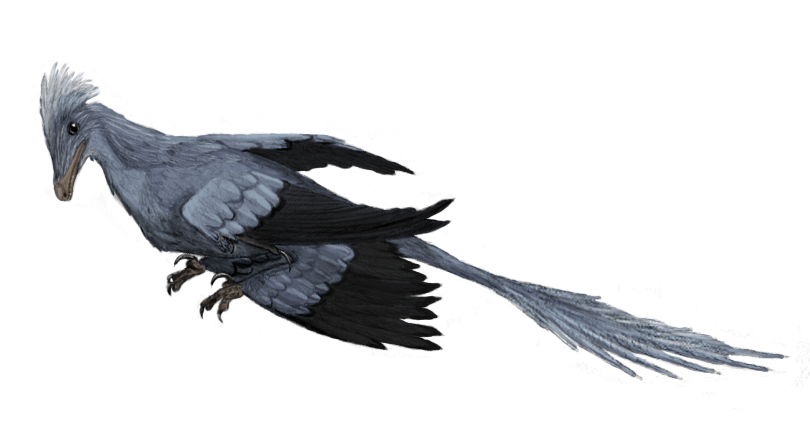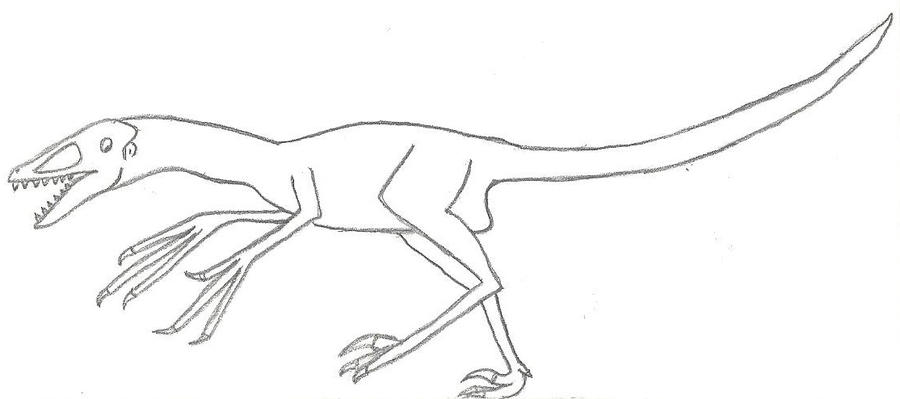A New and Extremely Inaccurate Method for Inferring the Integument of Extinct Maniraptors
By Alberta Claw and I. M. A. Troll
Email: albertonykus@gmail.com, internettroll@gmail.com
ABSTRACT
Since the description of Sinosauropteryx, a non-avian dinosaur preserved with filamentous feathers, in 1996, there has been a tendency in popular culture for professionals and dinosaur enthusiasts alike to insist on adding feathers to reconstructions of coelurosaurian dinosaurs. They have used subsequent findings of feathered dinosaurs since then to support this notion. In this paper we present a new method for inferring the integument of these dinosaurs and coin a name for this method, SRC (Spewing Random Crap). We also use this method to demonstrate that most non-avian maniraptors didn’t actually have feathers.
KEYWORDS
Maniraptors, feathers, scales, Jurassic Park, random crap, trolling
Introduction
The earliest reconstruction of a feathered non-avian dinosaur was that of a “Syntarsus” (now Megapnosaurus) by Sarah Landry, featured in Robert Bakker’s 1975 article The Dinosaur Renaissance, which we will not cite because neither of us has actually read it. Other early feathered dinosaur restorations were painted by Gregory Paul and Luis Rey, while Bakker also illustrated feathered Deinonychus in his book The Dinosaur Heresies, but we’re not going to cite that either because we’re mad that they turned out to be right.
In 1987, the first direct evidence of feathered non-avian dinosaurs was published in the form of a feather attachment surface found on the forelimb of the oviraptorosaur Avimimus, while in 1996 actual fossilized filamentous feathers were described in the description of the compsognathid Sinosauropteryx. Since then, feathers have been found associated with other non-avian coelurosaurs, such as the compsognathids Juravenator and Sinocalliopteryx and the tyrannosauroid Dilong. Among non-avian maniraptors, feathers have been found associated with the therizinosaur Beipiaosaurus, the alvarezsauroid Shuvuuia, the oviraptorosaurs Protarchaeopteryx, Caudipteryx, and Similicaudipteryx, the raptors deinonychosaurs Sinornithosaurus, Microraptor, Jinfengopteryx, and Anchiornis, and the indeterminate maniraptoran Yixianosaurus, while feather attachment surfaces have been found on the arm or tail bones of the deinonychosaurs Rahonavis and Velociraptor and the oviraptorosaur Nomingia. Almost all preserved maniraptor skin or skin impressions show feathers, while scales are have only been found on limited parts of the body such as the toes, the fingers, or the underside of the tail.
Using certain methods, such as phylogenetic bracketing, which we will ignore in this paper because we haven’t actually bothered to find out how they work, others have determined that it is most parsimonious to suppose that all non-avian maniraptors had feathers, and it is now typical for scientific artists to reconstruct them as such (Fig. 1). This is perfectly logical, but because we don’t think logically we will disregard all that evidence in this paper. The new method that we will introduce here is one that has been used by Internet trolls and stuck-up fanboys all over the World Wide Web, but has regretfully been overlooked by most mainstream scientists.
Figure 1. Scientifically accurate reconstruction of the raptor deinonychosaur Microraptor zhaoianus by Matt Martyniuk.
Materials and Methods
In this paper we will coin a new technical term for the new method utilized in this study, Spewing Random Crap (SRC). SRC is best utilized after one ignores all current evidence that contradicts their position, making it a highly biased objective and useful tool for pseudoscience. This method has been frequently used on the Internet, but, to the best of our knowledge, hasn’t appeared in many major publications until now. SRC consists mostly of committing numerous arbitrary logical and scientific fallacies in attempt to support one’s position and has been proven to be very effective at making the speaker look like a fool. SRC is an extension of the scientific method most commonly used by bad science and high school students, This Is The Conclusion, What Evidence* Can We Find To Support It? (TITCWECWFTSI).
Neither of us has actually studied any maniraptor fossils in person, but we (falsely) believe that we have gleaned enough information from unreliable Internet sources for us to apply SRC to the question of whether extinct maniraptors had feathers. We did so by making a list of arbitrary arguments we thought would not support the notion of feathered maniraptors without considering whether these arguments were accurate, logical, or even relevant. In this paper we shall refer to these arguments as Random Craps (RCs). Afterwards, we compared our results to a reliable source in an attempt to falsify our conclusions.
Specimens Examined
None. Not even photographs.
Results
Contrary to this paper, there’s good evidence that feathers were extensive and widespread among maniraptors (as mentioned in the introduction), and there’s no evidence at all any maniraptor lacked feathers, but, as a prerequisite to the use of SRC, we ignored the obvious conclusion that should have been drawn from that (i.e.: all maniraptors had feathers to some degree). After an hour or so or some other imprecise time interval of desperate thinking, we came up with the following list of RCs.
There is absolutely no evidence that maniraptors had feathers.
This completely contradicts our own introduction, but as the introduction was the only part of this paper for which we actually did any significant research and SRC requires ignorance of all contrary evidence, it was the first RC we were able to come up with.
Non-avian maniraptors with feathers preserved have only been found in Asia, so maniraptors found elsewhere wouldn’t have had feathers.
In reality, this is because soft tissue doesn’t fossilize well anyway and can only be preserved under special conditions that happened to be present in parts of Asia, but we overlooked that. And obviously if we really thought that this was the case we would argue that we shouldn’t reconstruct dinosaurs with eyeballs because eyeballs aren’t usually preserved in the fossil record. Also, by this argument we should also argue that elephant birds (from Madagascar) and terror birds (from the Americas) didn’t have feathers. But we’ll completely ignore that for no reason whatsoever, making this a classic example of an RC.
Maniraptor feathers were useless, so they lost them.
Translation: We couldn’t think of any reason non-avian maniraptors would need feathers, even though if we actually read through the relevant literature we’d know that many plausible functions for feathers have already been proposed.
Feathers are hard to maintain, which would’ve been difficult for non-avian maniraptors to do.
Modern birds can manage just fine, of course, but for no reason at all we assume that other maniraptors couldn’t. Our minds work in bizarre ways.
Saying all maniraptors had feathers is like saying all mammals have lion manes.
Hold on a second. A lion’s mane is a specialized display structure, not a universal characteristic (as the presence of integument usually is). Saying all maniraptors had feathers would be more akin to saying all mammals have hair, which happens to be correct. However, using bad analogies is our specialty. Bad analogies for the win!!!!1!1!1!111eleventy one!**
Maniraptors don’t look scary with feathers.
Duh! Of course, neither of us has actually experienced being nearly disemboweled by a cassowary or chased by a homicidal goose. We find it blindingly obvious that the appearances of living things that lived millions of years ago are directly controlled by personal perceptions of the two of us. Somehow, this counts as a scientific argument, except it doesn’t.
Through these RCs, we predicted that extinct maniraptors didn’t have feathers. We tried to falsify this prediction by watching the movie Jurassic Park about ten times (or maybe eleven times) as a test case. In this movie, the non-avian maniraptor “Velociraptor” (actually Deinonychus, due to the movie using taxonomy proposed by Gregory Paul***) features heavily. In none of these ten (or eleven) viewings did either of us notice any feathered “Velociraptor”. Therefore, we must conclude that our prediction was correct.
Discussion
We suggest that our RCs adequately show that extinct maniraptors didn’t have feathers. This is supported by the “Velociraptor” in Jurassic Park, even though that hardly represents what a living maniraptor looked like, and that movie was made before any non-avian dinosaurs preserved with actual feathers were discovered anyway. We could’ve come up with ten thousand more RCs, each more ridiculous than the last, but we wanted to play video games instead. We also suggest that extinct maniraptors had scales in place of feathers, because things that don’t have feathers obviously always have scales. We highly recommend that, in the future, reconstructions of maniraptors should make them completely scaly as they have always been (Fig. 2).**** We find that the SRC method is a useful method that can be applied to other fringe pseudoscientific problems, and in future publications we’ll use SRC to investigate other strongly-debated scientific concepts, except they aren’t strongly debated at all by mainstream scientists and are only “questioned” by Internet trolls (i.e.: the authors of this paper).
Figure 2. Pseudoscientific reconstruction of the raptor deinonychosaur Microraptor zhaoianus based on SRC by Albertonykus.
Conclusion
We have no clue what we are talking about, although we are very skilled at spouting pseudoscientific mumbo jumbo. This paper fails.
Acknowledgements
Special thanks to two anonymous reviewers who somehow slipped us past peer review, because we definitely couldn’t have made it otherwise. Also thanks to all the random trolls on the Internet for giving us ideas for RCs.
References
We intentionally forgot all our references either because they contradict us or because they’re too unreliable to begin with. If we actually included any references, people could look them up and see that they’ve already been rebutted ten thousand times by others (including in our own paper), so we won’t give them that pleasure.
Note from editor: This paper actually didn’t get past peer review, but we thought it would be instructive to include it.
Last minute note from senior editor: Don’t feed the trolls.












This is hilarious dude. Great work.
ReplyDeleteUtterly hilarious AND still informative, though I actually knew most of this. :P The editor's notes and the footnotes at the end take it up a notch in humor, though.
ReplyDeleteHilarious? This is science at it's best. I especially enjoyed reading about the rigorous methodology and all the stuff about dinosaurs.
ReplyDelete*slow clap*
ReplyDelete*tiny tear of joy shed*
Bravo, sirs.
Still find this hilarious
ReplyDelete